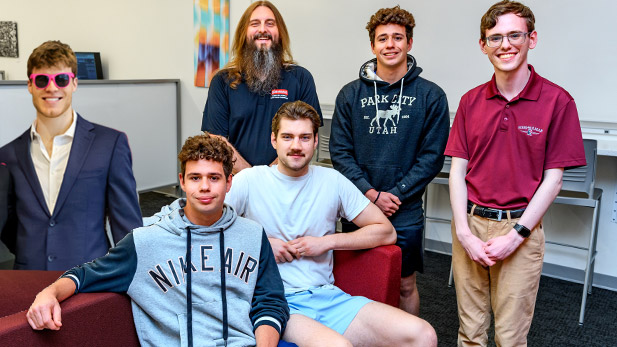Rose-Hulman Team Makes it to the Top 10 of the NASA Lunar Autonomy Challenge

A group of Rose-Hulman students finished in the top 10 of the prestigious NASA Lunar Autonomy Challenge. The challenge asked students to develop advanced software to guide a simulated lunar rover across a virtual moon environment.
A group of Rose-Hulman students made it into the top 10 of the prestigious NASA Lunar Autonomy Challenge. The challenge asked students to develop advanced software to guide a simulated lunar rover across a virtual moon environment. They were also tasked with autonomously mapping the moon’s rugged terrain—pinpointing rocks, charting elevation, and navigating complex surfaces—all while operating within a fully simulated environment.
What started as a competition among 31 teams from colleges and universities in 15 states came down to 10. Rose-Hulman was selected among schools including Harvard, Carnegie Mellon, MIT, Stanford and Johns Hopkins University.
Henry Krzyzewski, a senior computer science major, is leading the group, which also includes Brian Beasley (junior, computer science), Matteo Calviello (junior, computer science), Tommaso Calviello (junior, computer science), Lance Fowler (junior, mechanical engineering), and Jacob Scheibe (junior, computer science). Krzyzewski heard about the challenge when he was interning at Caterpillar in summer 2024 and his manager at the time encouraged him to look into the opportunity.
The NASA Lunar Autonomy Challenge is made up of three rounds. The first round was the initial selection of teams that moved on to a qualifying round. In that round, students virtually explored and mapped the lunar surface using a digital twin of NASA’s lunar mobility robot, the ISRU Pilot Excavator (IPEx). Teams developed software that can perform set actions without human intervention, navigating the digital IPEx in the harsh, low-light conditions of the Moon. The top 10 scoring teams then proceeded to the final round.
“We’ve been working in different areas of perception, navigation, localization, and energy management and have made a lot of progress thanks to the efforts of the team,” said Krzyzewski. “For the final round, we’ve been developing a convolutional neural network for pose estimation to help with our position estimation as of late.”
A convolutional neural network (CNN) is a type of deep learning algorithm specifically designed for processing data with a grid-like structure, such as images. In this case, Krzyzewski and his team are using the CNN to determine the lander’s position in order to correlate their position in the world. This is a long, technical process that includes reviewing upwards of 7,000 images the CNN produces, which the team then validates and tests.
“We’ve put in so many hours on this,” said Krzyzewski “During one of the submission deadlines, we were in one room from 12-14 hours a day for four days in a row. It was intense, but it was a great engineering experience.”
Aaron Wilkin, assistant professor of computer science and software engineering, is the group’s advisor. He believes that students like these working on the NASA Lunar Autonomy Challenge are what makes him proud to be a professor at Rose.
“The diverse skills (in robotics and software) required to complete this project necessitated exceptionally strong students from various departments, and I am delighted to witness such remarkable collaboration to such a degree,” said Wilkin.
“The substantial number of hours dedicated by these students is alone impressive. However, to make it to the top 10 in competition with teams from top schools — which include graduate students and even professionals — truly demonstrates the talent and strengths of students at Rose. The determination, autonomy, skill set, and accomplishments of this team have greatly impressed and inspired me, and we should all be proud of their achievements.”
Krzyzewski credits Rose-Hulman’s Computer Science Department and its alumni at Crusoe for ensuring the team was successful from the start. Crusoe is a climate-aligned digital infrastructure company which provides an AI cloud platform optimized for GPU intensive training and inference workloads. Crusoe Cloud provides highly available, price-performant GPU VMs to top AI startups including Together AI, Decart, and Codium (now Windsurf). Crusoe also builds hyperscale data centers, including those for OpenAI's Stargate project. The company gave Krzyzewski and his team members free credits to use their hardware and computing in order to compete in the NASA Lunar Autonomy Challenge.
Krzyzewski, who is originally from Naperville, Illinois, accepted a full-time offer from Caterpillar upon graduation. He will work on vehicle electrification for their better management system software. He believes this experience, as well as other team challenges during his years at Rose, have helped him gain not only technical experience and expertise, but also built his management skills.
“I’ve led a few teams at Rose, and each time, I think I can do better,” said Krzyzewski. “This experience leading the NASA Lunar Autonomy Challenge has been the most comfortable I’ve been with a group in terms of developing strong management experience, working with people, resources and organization.”